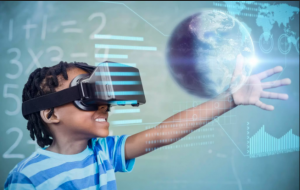The year 2020 has been largely defined by unprecedented changes in healthcare and all levels of education. The global COVID-19 pandemic forced the healthcare industry’s hand in revising its virtual care guidelines and laws, pushing to allow digital doctor’s visits for non-life-threatening appointments. Likewise, with isolation orders doled out across the globe, teachers, parents, and students from pre-kindergarten all the way through graduate school had to become accustomed to new ways of teaching and learning.
In March, George Washington University (GWU) paved the way for virtual reality (VR) learning when clinicians used the system to paint a better picture of how the virus affected its first patient’s lungs. GWU had previously used VR to help patients see what was happening within their own bodies. This time, the university implemented Oculus headsets and VR software to help clinicians view the disease radiographically. Entire healthcare teams could conference in and view the new angle together and discuss findings live.
Since then, VR has provided healthcare students with a rare depth of information from afar. “I really think that what is going to make VR stick is the ability to do things you couldn’t normally do in other modalities,” says Dr. Warren Wiechmann, Associate Dean of Clinical Science Education and Educational Technology at the University of California Irvine School of Medicine. “I like this idea of putting yourself in scenarios you normally couldn’t be in to increase training and increase exposure.”
GWU isn’t the only school jumping on board. The University of Washington in Seattle uses VR not just in traditional classrooms, but to help teach mindfulness to patients, asking them to immerse themselves in certain scenarios to train their minds where to set their focus. The National Council of State Boards of Nursing has said that up to half of clinical educational experiences could be adequately taught via VR.
While some may worry that VR will never be the same as traditional, hands-on learning, and that important aspects of the lesson would be lost, others argue that the ability for students learning VR to practice repeatedly before performing an action on a patient could only improve the learning process. With the need for healthcare workers increasing faster than in-person classrooms are reopening their doors, VR learning is likely here to stay.























